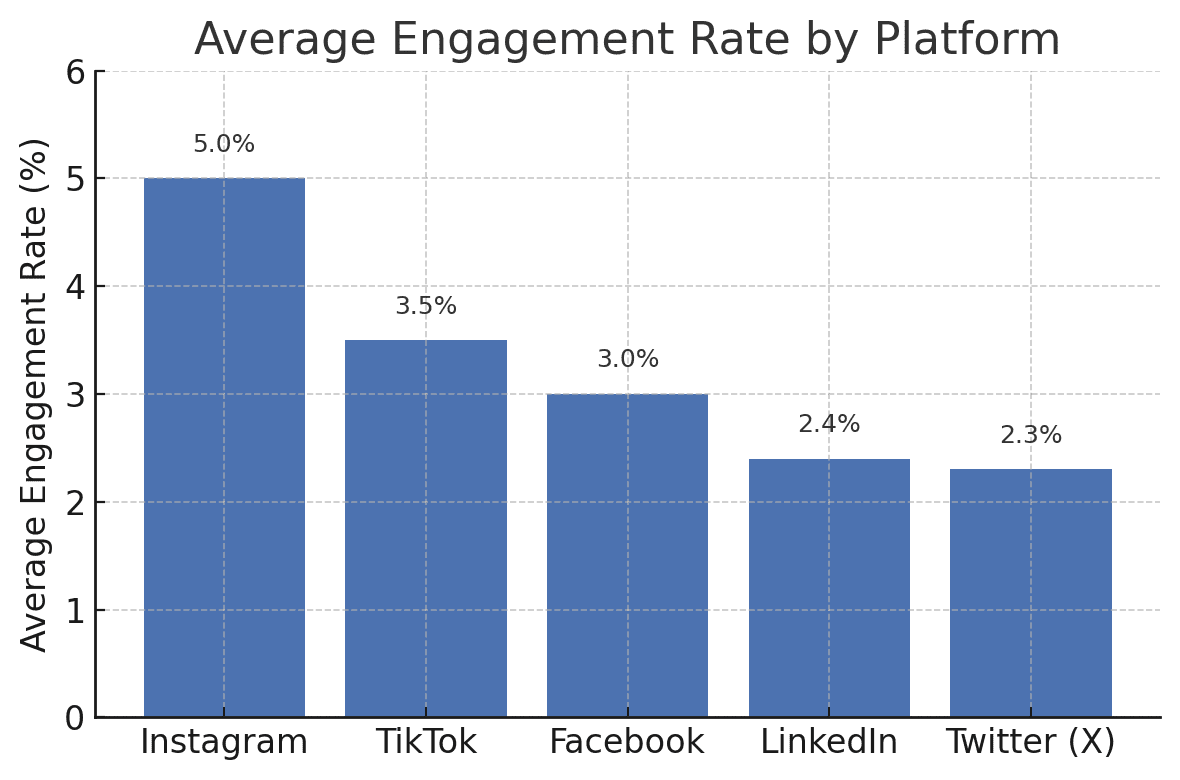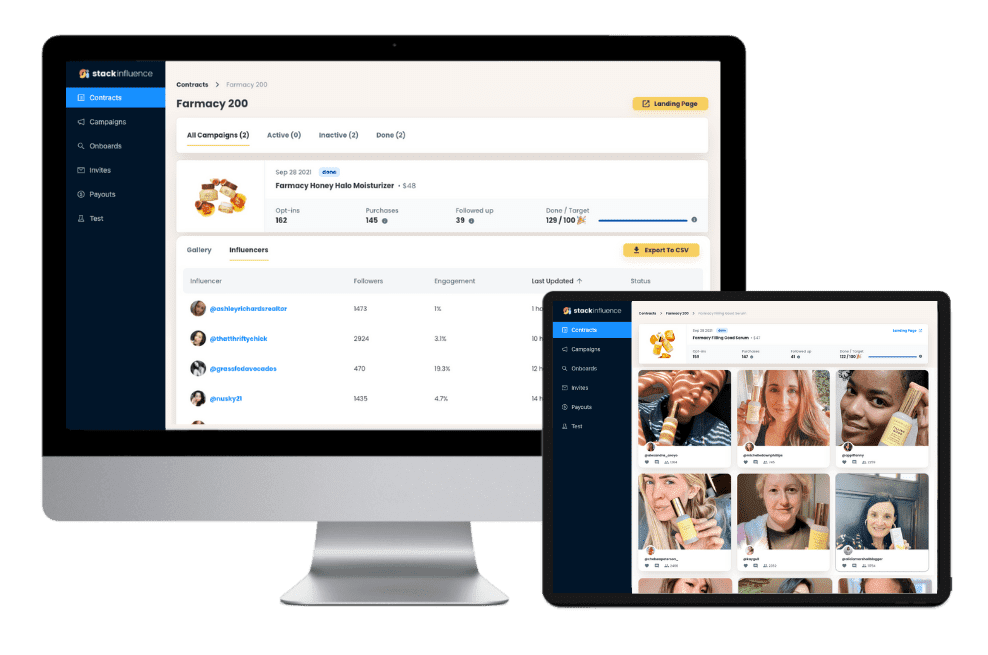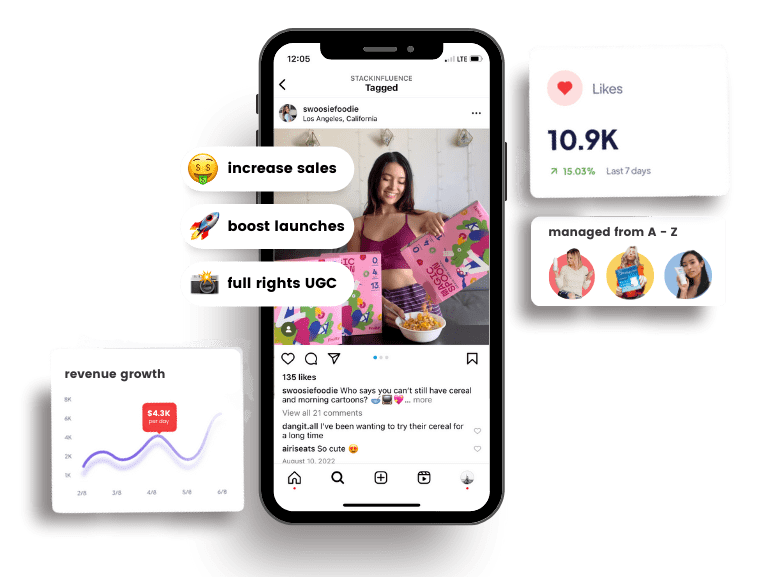What Is the Average Influencer Engagement Rate in 2025?
15th
July, 2025
Influencer Marketing
Amazon Marketplace
Artificial Intelligence
TikTok Tips
In the fast-paced world of social media marketing, engagement rate is one of the most telling metrics of success. For e-commerce brands and Amazon sellers leveraging influencer collaborations, understanding engagement rates is crucial. It answers the big question: Are people actually interacting with the content? A high engagement rate means an influencer’s audience is liking, commenting, sharing – in short, actively paying attention. A low rate can ring alarm bells about fake followers or bland content. In this blog post, we’ll break down what counts as an average (and good) influencer engagement rate on social platforms, why it matters for e-commerce marketers, and how micro-influencers, content creators, and UGC (user-generated content) play into the equation. We’ll also share some tips to boost engagement and a few handy charts to put the benchmarks in perspective. Let’s dive in!
Understanding Engagement Rate (and Why It Matters)
Engagement rate is a measure of how actively an audience interacts with an influencer’s content. It’s typically expressed as a percentage of followers (or viewers) that engage. The formula can be as simple as:
Engagement Rate (%) = (Total interactions on a post / Total followers) × 100%
“Interactions” usually include likes, comments, shares, saves, and clicks – basically any action showing the audience is interested and involved. For example, if an Instagram post has 500 likes and comments combined and the influencer has 10,000 followers, the engagement rate is 5%. Higher engagement means the content resonates strongly with followers.
Why do e-commerce and Amazon sellers care about this? Because engagement is often a proxy for trust and influence. If an influencer’s audience frequently engages, it suggests they find the content valuable and the creator credible. High engagement builds trust, which is gold for brands hoping an influencer’s followers will take product recommendations seriously. On the flip side, a huge follower count with very little engagement can indicate a disconnected audience (or even bot followers). As one guide notes, “high engagement is a sign of trust and loyalty and hence a good indicator of success for many influencers.” In short, an influencer with 50k followers and a 5% engagement rate is often far more impactful than one with 500k followers but a 0.5% engagement rate.
Moreover, social platform algorithms favor engagement. Content that sparks more interactions tends to get boosted to more users. That means influencers (or brands) with better engagement can enjoy higher organic reach. For e-commerce brands, that can translate into more eyes on your products without paying for ads. Engagement rate also helps cut through vanity metrics. It’s a reality check beyond follower counts – reminding marketers that an active community beats a big but silent audience any day.
These figures represent recent benchmark data (late 2024 – early 2025) from credible industry analyses:
| Platform | Nano (1K–10K) | Micro (10K–100K) | Macro (100K–1M) | Mega (1M+) |
| ~1.7% (highest) | ~0.7% | ~0.6% | ~0.7% | |
| TikTok | ~10% (very high) | ~8% | ~7% | ~7–8% |
| YouTube | ~2% | ~2–3% (mid-tier peak) | ~3.5% (peak) | ~3.4% |
| ~0.5–1% (est.) | ~0.3–0.5% (est.) | ~0.2% (est.) | ~0.1% (est.) | |
| ~8% (est.) | 6% (strong) | ~3% (est.) | ~2% | |
| X (Twitter) | ~1% (est.) | ~0.5% (est.) | ~0.2–0.3% (est.) | ~0.1% (est.) |
Average Engagement Rate Benchmarks Across Social Platforms

It’s important to realize that “average” engagement rates vary by platform. Social networks have different norms and user behaviors. For instance, Instagram is known for higher engagement relative to other platforms, thanks to its visual nature and interaction-friendly interface (double taps, story replies, etc.). TikTok, with its addictive short-form videos, can drive a ton of interaction as well. Meanwhile, Twitter (now X) and LinkedIn generally see lower engagement rates on posts – users might quickly scroll through updates without interacting as much.
Recent benchmark data highlights these differences. According to a Q4 2024 social media analysis, Instagram posts average around a 5.0% engagement rate, one of the highest across networks. TikTok isn’t far behind with roughly 3.5% average engagement. Facebook sits around 3.0%, while LinkedIn averages about 2.4%, and Twitter (X) comes in last at approximately 2.3%. These numbers make sense – a flashy product photo on Instagram or a catchy TikTok video naturally elicits more quick reactions than a text update on LinkedIn.
To put this into perspective, have a look at the chart below comparing typical engagement rates across major platforms:
Average engagement rate benchmarks by social media platform (Instagram tends to see higher interaction rates than Facebook, Twitter (X), or LinkedIn).
If your brand or influencer posts are getting ~2% engagement on Twitter but 6% on TikTok, that’s completely normal. Each platform’s audience behaves differently. Don’t panic if one channel underperforms another – instead, judge against the right benchmark. For example, a 3% engagement on Instagram might be mediocre (since IG’s average is around 5%), but that same 3% on Twitter would be outstanding. The key is to compare apples to apples: measure your Instagram engagement vs. Instagram norms, TikTok vs. TikTok norms, and so on.
Also consider industry differences. Engagement benchmarks can vary by niche or sector. (A fashion influencer’s audience might habitually like and comment more than, say, a B2B industry influencer’s audience.) One set of benchmarks from Hootsuite showed overall average engagement ~2% on Instagram across all industries, but higher in some sectors like media or sports. The main point is that “average” isn’t one-size-fits-all – use it as a reference point, not a rigid standard.
Engagement Rate by Influencer Size: Micro vs. Macro

When evaluating influencers, size matters – but maybe not in the way you’d think. It turns out micro-influencers often generate a higher average engagement rate than macro- or mega-influencers. “Micro” generally refers to creators with tens of thousands of followers (not millions), whereas “macro” influencers have hundreds of thousands, and “mega” are the true celebrities with millions. Multiple studies have confirmed an inverse relationship between audience size and engagement rate: as follower count goes up, engagement percentage tends to drop.
For example, micro-influencers (say 10k–100k followers) might average in the ballpark of 3–6% engagement per post, while macro influencers (100k+ followers) see closer to 1–2% on average. That means a micro-influencer’s smaller audience is proportionally far more active and interactive. One analysis found that on Instagram, micro-influencers around this range enjoy roughly a 3.86% engagement rate, compared to only 1.21% for much larger influencers. In fact, micro influencers receive about 60% more engagement (relative to their audience size) than big-name influencers.
To visualize this contrast, check out the chart below. It compares an example average engagement rate for micro-influencers vs. mega influencers on Instagram:
Engagement rate comparison by influencer follower size: smaller “micro” influencers often see a significantly higher % of their followers engaging with content than do mega-influencers with millions of followers.
As you can see, a creator with, say, 50k followers might routinely get 5%+ of their audience engaging. Meanwhile, a celebrity account with 5 million followers may only spark engagement from ~1–2% of that massive audience. The reasons? Niche focus and community connection. Micro-influencers tend to cultivate tight-knit, highly interested communities. Their content is often more relatable and dialogue-driven. Followers see them as genuine peers or experts in a specific niche, whether it’s eco-friendly beauty or gourmet baking. There’s a sense of trust and friendship that drives more likes and comments. On the other hand, macro influencers – with their broad, diverse following – inevitably have a more passive audience. It’s hard to maintain the same level of personal connection when you’re speaking to millions of people.
From an e-commerce perspective, this is big news. It means that if you’re a brand looking for engagement (and ultimately conversions), partnering with a bunch of micro-influencers could deliver more bang for your buck than paying one superstar. Micro-influencers not only charge lower fees, but their followers are actually listening and interacting at a higher rate. For example, an Amazon seller launching a new kitchen gadget might get better results working with 10 cooking enthusiasts who each have 25k very engaged followers, than blowing the whole budget on one cooking celebrity with 1 million followers who yields only lukewarm engagement. As one marketing firm succinctly put it: “micro influencers may get fewer eyeballs overall, but the ones they reach are far more likely to click, comment, and convert.”’

Unlock the Power of Micro Influencers and Elevate your Brand Today!

What Is Considered a “Good” Engagement Rate?
We’ve talked about averages – but what counts as good? Here’s a general rule of thumb often cited by marketers and influencer platforms:
-
Less than 1%
Engagement is low. This is below average on most platforms. If an influencer or brand page is under 1%, it might be a sign to re-evaluate content strategy or check for issues (e.g. irrelevant audience or fake followers).
-
1% to 3%
A solid engagement rate on most social media. Most brands and influencers fall into this range, hovering around the middle of the pack. If you’re in this range, you’re doing okay – roughly keeping pace with typical benchmarks.
-
3% to 5%
High engagement. Hitting 3%+ consistently means your audience finds your content very appealing. Many would consider 3-5% an indicator that the influencer is above average in connecting with followers.
-
Above 5%
Excellent engagement. Anything above five percent is top-tier (especially if sustained over many posts). This often means the content is viral or highly niche-relevant, provoking lots of interaction. Influencers with engagement in this territory are punching well above the norm. As Influencity’s research notes, engagement above 5% means your content is “making a real impact” with the audience.
Keep in mind these are broad strokes. What’s “good” can differ by platform and audience size. For instance, a TikTok creator might regularly see 10%+ engagement (due to how the For You page spreads content widely), so their bar for “excellent” might be higher than 5%. Meanwhile, a LinkedIn content creator might consider 2% very good because that platform’s interactions are generally lower. Context is everything – compare within the right frame of reference and consider the typical engagement in your specific community or industry niche.
Also remember that quality of engagement matters. 100 genuine comments (“I love this product, where can I buy it?”) are worth more than 1,000 random “nice pic!” comments from bots or disengaged followers. If you’re evaluating an influencer for a campaign, look deeper than the percentage: Are the comments meaningful? Is the audience asking questions, tagging friends, showing real interest? An influencer might have a 6% engagement rate, but if that engagement is mostly low-effort or off-topic, it’s less valuable. On the other hand, a niche content creator could have a modest 2% rate, but if those interactions are thoughtful and on-target (from exactly your customer demographic), it might still be a great partnership opportunity for your brand.
In summary, use engagement rate benchmarks as a guideline, but don’t obsess over them in isolation. Consistent growth and audience alignment often matter more. If your brand’s account or your influencer partner’s account is steadily rising from 2% to 3% to 4% over a few months, that trend is a great sign – keep doing what works. The upward momentum and loyalty being built are more important than hitting an arbitrary number.
Tips to Improve Engagement Rate
Maybe you’ve checked the numbers and aren’t thrilled with where your engagement stands – or you just want to keep pushing it higher (who wouldn’t?). Whether you’re a content creator or a brand managing your own social media, here are some battle-tested tips to boost engagement rate:
1. Create High-Quality, Relevant Content
This might sound obvious, but it’s the foundation. Posts should catch the eye (clear images or videos, interesting visuals) and provide value. For an e-commerce brand, that could mean sharable how-to videos, beautiful photos of your product in use, or funny relatable memes in your niche. Quality content that either entertains, educates, or inspires will naturally invite more likes and shares. Don’t be too “salesy” in every post – mix in genuine content that sparks conversation.
2. Know Your Audience & Be Niche
Tailor your content to what your followers care about. Use analytics to see what types of posts have gotten the most engagement in the past. Lean into your niche. An Amazon seller in home decor might engage people with DIY interior design tips, not just product photos. When content feels specifically relevant to a follower’s interests, they’re more likely to interact. (This is why micro-influencers do well – their niche expertise attracts a passionate audience.)
3. Post Consistently (at the Right Times)
Inactive or erratic posting can cause your audience to drift away. Maintain a consistent posting schedule so followers know you’re active and to keep your content on their radar. At the same time, don’t overwhelm with too many posts (quality over quantity). It’s also key to post when your audience is actually online – if that means weekday evenings or Saturday morning, time your content accordingly for maximum visibility and engagement.
4. Collaborate with Influencers or Creators
Brands can boost their own social engagement by partnering with influencers (yes, influencers collaborating with influencers is a thing, and brands collaborating with influencers definitely is). For instance, an e-commerce brand might do an Instagram Live Q&A with a content creator, or co-create a piece of content. These collaborations often bring an influencer’s highly engaged audience over to interact with your brand, effectively cross-pollinating engagement. As a platform that connects micro-influencers with e-commerce campaigns, Stack Influence has seen how a well-matched influencer partnership can rev up engagement and sales simultaneously.
By implementing these tactics, you’ll be well on your way to boosting that engagement rate. Remember, growth takes time – so stay consistent and keep the content authentic. Over time, you should see those likes, comments, saves, and shares trend upward.

Unlock the Power of Micro Influencers and Elevate your Brand Today!

Why Engagement Rate Matters for E-Commerce Brands
If you’re an e-commerce brand or Amazon seller, you might wonder how all this influencer engagement rate talk translates to real business outcomes. The truth is, engagement rate can be a proxy for conversion potential. When an influencer’s audience is highly engaged, they’re not just passively scrolling – they’re paying attention and interacting. This typically means they trust the influencer’s voice and value their content. So if that influencer features your product, a high percentage of engaged followers are likely to notice and consider it, if not act on it.
Micro-influencers in particular are powerful allies for e-commerce. Their content often comes across as authentic UGC, like a friend sharing a recommendation. This authenticity leads to better engagement and can drive higher conversion rates. As noted earlier, a micro-influencer’s followers are more likely to click links (such as an Amazon product link), use a promo code, or leave a review after purchase, because they feel a closer connection and trust. In influencer marketing ROI terms, higher engagement often correlates with higher ROI – you’re getting more actual interaction and potential customers for the money you spend.
Moreover, engagement on influencer posts can create a halo effect for your brand’s own social media. If an influencer’s followers start talking about your product in the comments (“I need this!” or “Does anyone have one? How is it?”), that buzz can spill over. You might see increased followers on your brand account, more comments on your posts, and more UGC as people share their experiences. All of this social proof builds credibility for new shoppers who discover your brand.
Finally, algorithmically speaking, when an influencer’s post about your product gets strong engagement, it’s more likely to be shown to additional users (via Instagram’s Explore page, TikTok’s For You Page, etc.). That means extra exposure beyond the influencer’s follower list – essentially bonus impressions and engagement that you didn’t even pay for. It’s like compounding interest on your influencer investment, courtesy of the social network algorithms rewarding engaging content.
In short, if you’re investing in influencer marketing, don’t just chase follower counts. Pay close attention to engagement rates. An influencer with a modest but active audience is often a smarter choice for e-commerce campaigns aiming for sales or brand awareness. The engagement rate is a signal that “this creator’s audience cares about what they post” – and by extension, they might care about your product when it’s featured.
Conclusion To What Is the Average Influencer Engagement Rate in 2025?
Understanding the average influencer engagement rate – and what influences it – is key to making savvy marketing decisions in 2025. To recap, engagement rate tells you how well an influencer’s content resonates with their followers. On platforms like Instagram and TikTok, average rates hover a few percent, while Twitter and LinkedIn see lower typical engagement. “Good” engagement (3%+ and above) beats the averages and indicates an influencer likely has a real rapport with their audience. We’ve seen that micro-influencers often shine here, delivering higher engagement percentages than their macro counterparts. For e-commerce brands and Amazon sellers, those highly engaged niche communities can translate into more meaningful interactions, traffic, and conversions.
As you plan your influencer campaigns or build your own social media presence, use the benchmarks and tips above as a guide. Track your metrics, celebrate steady improvements, and don’t be afraid to adjust your strategy based on what the data (and your audience) tell you. Whether you’re collaborating with a network of micro-influencers via a platform like Stack Influence or creating content in-house, the goal is the same: capture the attention and hearts of your target audience so they engage with your content – and eventually, with your brand or product.
In the age of content overload, an engaged audience is like gold. When you see those likes, comments, and shares flowing, you know you’re not just speaking into the void – you’re building a community. And ultimately, that’s what turns social media from just numbers into true business value. So keep an eye on those engagement rates, keep refining your approach, and watch as a “good” engagement rate leads to even greater marketing success.

By William Gasner
CMO at Stack Influence
William Gasner is the CMO of Stack Influence, he's a 6X founder, a 7-Figure eCommerce seller, and has been featured in leading publications like Forbes, Business Insider, and Wired for his thoughts on the influencer marketing and eCommerce industries.
Want new articles before they get published? Subscribe to our Awesome Newsletter.
stack up your influence
turning creativity into currency
our headquarters
111 NE 1st St, Miami, FL 33132
our contact info
[email protected]
stack up your influence
turning creativity into currency
our headquarters
111 NE 1st St, 8th Floor
Miami, FL 33132


